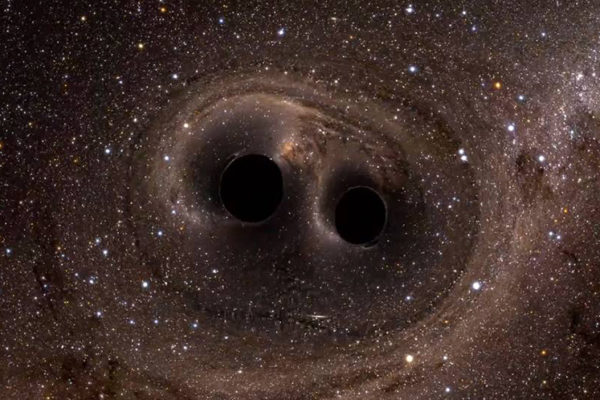AUSTIN, Texas — The scientists looking for gravitational waves reported that last year they observed four additional ripples in space-time. During about a nine-month period, scientists involved with the National Science Foundation’s LIGO (Laser Interferometer Gravitational-Wave Observatory) collaboration and the European-based Virgo gravitational-wave detector encountered eight gravitational waves — twice as many as previously reported — including a newly identified binary black hole that was the most precisely located in the sky to date.
Gravitational waves are events that warp the fabric of space-time. They are created when massive celestial bodies crash into each other, such as two black holes or neutron stars, the dense stars believed to form when a much larger star collapses. LIGO’s first detections of gravitational waves came in 2015, followed by eight detected last year, including a previously reported observation of two neutron stars colliding. Five of last year’s observations, including the neutron-star collision, occurred between Aug. 9 and Aug. 23, at a time when Aaron Zimmerman, now an assistant professor of physics at The University of Texas at Austin, and two colleagues were initially responsible for determining the sources of these waves.
The LIGO and Virgo teams work to measure properties of colliding celestial bodies: their mass, motion and other characteristics. Among the gravitational waves first published about today was an event caused when two black holes crashed into each other 2.5 billion light-years from Earth. Scientists detected and later worked to precisely pinpoint where the black-hole collision took place. The Virgo detector in Italy joined the two LIGO detectors in the United States in early August 2017, allowing for the greater level of precision. Scientists pinpointed the event within 39 square degrees — meaning they mapped it to a region that equates to about 0.0024 percent of the sky.
“Every time you add another detector, you do better at localizing the event in the sky,” Zimmerman said. “Black holes don’t emit light, so we don’t expect astronomers to have anything to visually look for, but this represents the future. We’re getting to a point where these events are localized better and better.”
Another event first reported today was detected on July 29, 2017. Analysts since determined it was the most massive and distant gravitational-wave source observed so far: a binary black hole from about 5 billion years in the past. Detections of gravitational waves are starting to allow for a more comprehensive census of the universe, Zimmerman said.
“These signals teach us about how stars throughout the universe live out their lives — go supernova, become black holes or neutron stars or other things,” Zimmerman said. “With what we learn, we can start to map out the structure of the universe and its history.”
Over the weekend, scientists attending the Gravitational Wave Physics and Astronomy Workshop in College Park, Maryland, presented their results, which were published today on the arXiv repository of electronic preprints. One paper is a catalog of all the gravitational wave detections so far, and the second is a study describing the characteristics of the population of black holes that collide.
“The next observing run, starting in spring 2019, should yield many more gravitational wave candidates, and the science the community can accomplish will grow accordingly,” says David Shoemaker, spokesperson for the LIGO Scientific Collaboration and senior research scientist in the MIT Kavli Institute for Astrophysics and Space Research. “It’s an incredibly exciting time.”
The Collaborations
LIGO is funded by NSF and operated by Caltech and MIT, which conceived of LIGO and led the Initial and Advanced LIGO projects. Financial support for the Advanced LIGO project was led by the NSF with Germany (Max Planck Society), the U.K. (Science and Technology Facilities Council) and Australia (Australian Research Council-OzGrav) making significant commitments and contributions to the project. More than 1,200 scientists from around the world participate in the effort through the LIGO Scientific Collaboration, which includes the GEO Collaboration. A list of additional partners is available at https://my.ligo.org/census.php.
The Virgo collaboration consists of more than 300 physicists and engineers belonging to 28 European research groups: six from Centre National de la Recherche Scientifique (CNRS) in France; 11 from the Istituto Nazionale di Fisica Nucleare (INFN) in Italy; two in the Netherlands with Nikhef; the MTA Wigner RCP in Hungary; the POLGRAW group in Poland; Spain with IFAE and the Universities of Valencia and Barcelona; two in Belgium with the Universities of Liege and Louvain; Jena University in Germany; and the European Gravitational Observatory (EGO), the laboratory hosting the Virgo detector near Pisa in Italy, funded by CNRS, INFN and Nikhef. A list of the Virgo Collaboration can be found at http://public.virgo-gw.eu/the-virgo-collaboration/. More information is available on the Virgo website at www.virgo-gw.eu.
